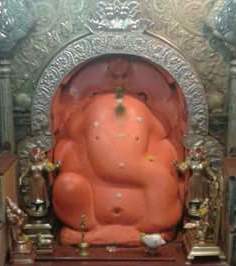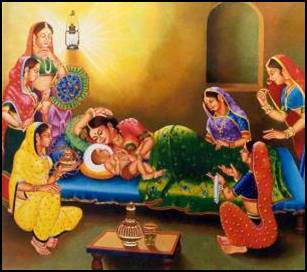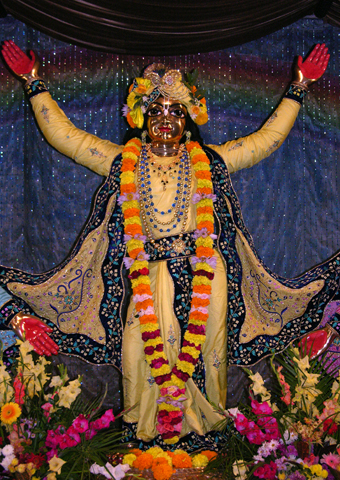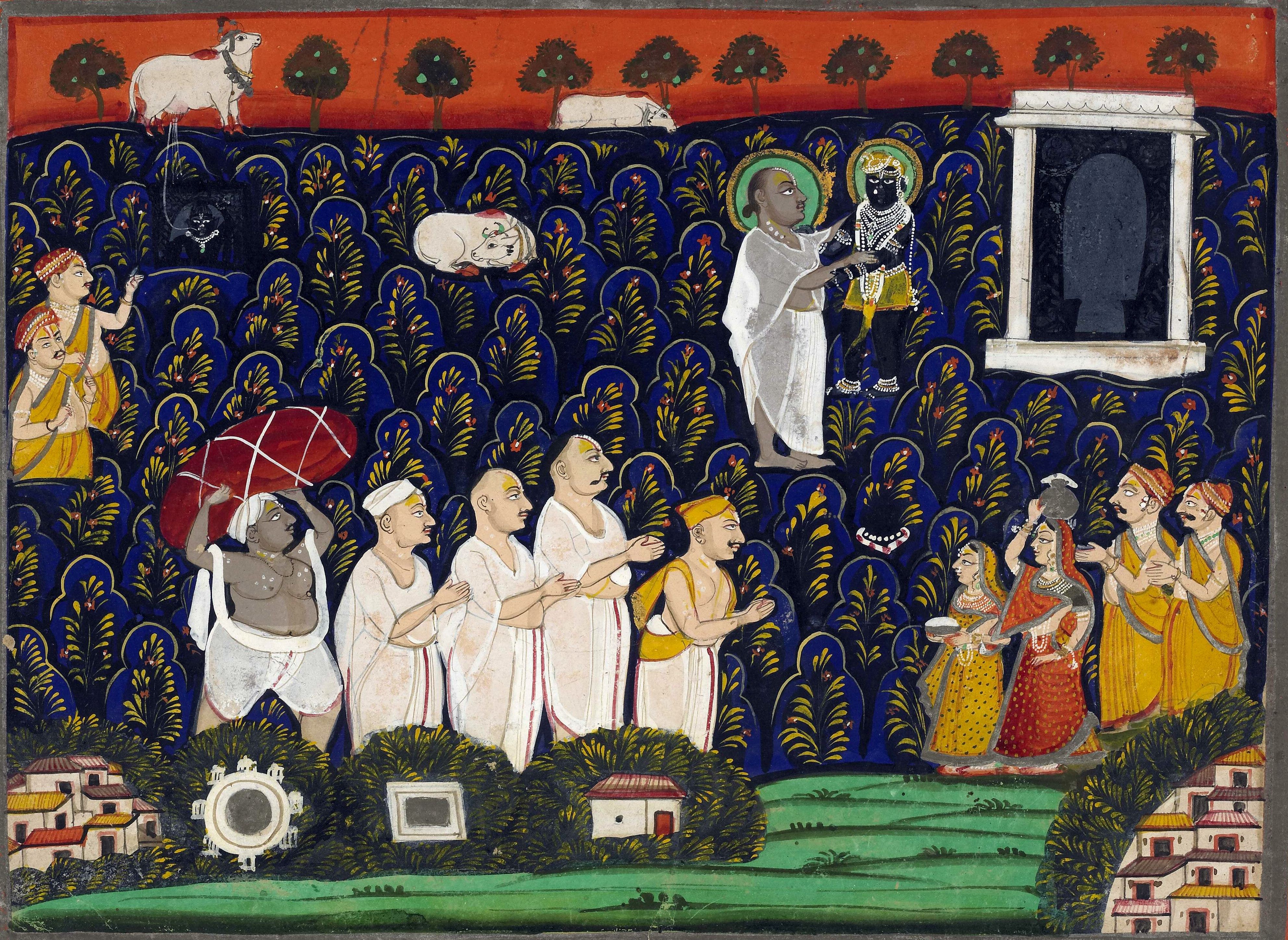|
Arati
''Arti'' (Sanskrit: Ārātrika, Hindi: Ārtī) is a Hindu ritual employed in worship, often part of ''puja'', in which light (usually from a flame) is offered to one or more deities. ''Arti(s)'' also refers to the songs sung in praise of the deity, when the light is being offered. Origin Arti is derived from the Sanskrit word () which means something that removes , darkness (or light waved in darkness before an icon). A Marathi language reference says it is also known as ( sa, महानीराञ्जना). ''Arti'' is said to have descended from the Vedic concept of fire rituals, or '' homa/yajna''. In the traditional ''arti'' ceremony, the flower represents the earth (solidity), the water and accompanying handkerchief correspond with the water element (liquidity), the ghee or oil lamp represents the fire component (heat), the peacock fan conveys the precious quality of air (movement), and the yak-tail fan represents the subtle form of ether (space). The incense re ... [...More Info...] [...Related Items...] OR: [Wikipedia] [Google] [Baidu] |
Sanskrit
Sanskrit (; attributively , ; nominalization, nominally , , ) is a classical language belonging to the Indo-Aryan languages, Indo-Aryan branch of the Indo-European languages. It arose in South Asia after its predecessor languages had Trans-cultural diffusion, diffused there from the northwest in the late Bronze Age#South Asia, Bronze Age. Sanskrit is the sacred language of Hinduism, the language of classical Hindu philosophy, and of historical texts of Buddhism and Jainism. It was a lingua franca, link language in ancient and medieval South Asia, and upon transmission of Hindu and Buddhist culture to Southeast Asia, East Asia and Central Asia in the early medieval era, it became a language of religion and high culture, and of the political elites in some of these regions. As a result, Sanskrit had a lasting impact on the languages of South Asia, Southeast Asia and East Asia, especially in their formal and learned vocabularies. Sanskrit generally connotes several Indo-Aryan lang ... [...More Info...] [...Related Items...] OR: [Wikipedia] [Google] [Baidu] |
Hindu
Hindus (; ) are people who religiously adhere to Hinduism.Jeffery D. Long (2007), A Vision for Hinduism, IB Tauris, , pages 35–37 Historically, the term has also been used as a geographical, cultural, and later religious identifier for people living in the Indian subcontinent. The term ''"Hindu"'' traces back to Old Persian which derived these names from the Sanskrit name ''Sindhu'' (सिन्धु ), referring to the river Indus. The Greek cognates of the same terms are "''Indus''" (for the river) and "''India''" (for the land of the river). The term "''Hindu''" also implied a geographic, ethnic or cultural identifier for people living in the Indian subcontinent around or beyond the Indus River, Sindhu (Indus) River. By the 16th century CE, the term began to refer to residents of the subcontinent who were not Turkic peoples, Turkic or Muslims. Hindoo is an archaic spelling variant, whose use today is considered derogatory. The historical development of Hindu self-i ... [...More Info...] [...Related Items...] OR: [Wikipedia] [Google] [Baidu] |
Sukhakarta Dukhaharta
''Sukhakarta Dukhaharta'' (literally "harbinger of happiness and dispeller of distress", mr, सुखकर्ता दु:खहर्ता, ), also spelled as ''Sukhkarta Dukhharta'', is a popular Marathi arati song or bhajan (devotional song) dedicated to the Hindu god Ganesha, composed by the saint Samarth Ramdas (1608 - 1682 CE). It is included in the "most standard and almost universal" arati songs sung at the end of Puja (worship rituals) of Ganesha in Maharashtra, especially in his festival Ganesh Chaturthi as well as in Ganesha temples in the region. Background Ganesha is the Hindu god of wisdom, knowledge and new beginnings. He is depicted with an elephant head. Samarth Ramadas was inspired to compose the arati by seeing the icon of Mayureshwara (a form of Ganesha) at Morgaon Ganesha Temple, the chief shrine in the Ashtavinayaka pilgrimage circuit, consisting of eight Ganesha temples around Pune. The arati is composed in the raga (musical mode) Jogiya (Jogia) ... [...More Info...] [...Related Items...] OR: [Wikipedia] [Google] [Baidu] |
Swaminarayan
Swaminarayan ( IAST: ', 3 April 1781 – 1 June 1830), also known as Sahajanand Swami, was a yogi and ascetic, who is believed by followers to be a manifestation of God Krishna, or as the highest manifestation of Purushottam, and around whom the Swaminarayan Sampradaya developed. In 1800, he was initiated into the ''Uddhav'' ''sampradaya'' by his guru, Swami Ramanand, and was given the name Sahajanand Swami. Despite opposition, in 1802 Ramanand handed over the leadership of the Uddhav Sampraday to him before his death. According to the Swaminarayan-tradition, Sahajanand Swami became known as Swaminarayan, and the Uddhav Sampraday as the Swaminarayan Sampradaya, after a gathering in which he taught the Swaminarayan Mantra to his followers. He emphasized "moral, personal, and social betterment," and ''ahimsa'', and is also remembered within the sect for undertaking reforms for women and the poor, and performing non-violent yajñas (fire sacrifices) on a large scale. ... [...More Info...] [...Related Items...] OR: [Wikipedia] [Google] [Baidu] |
Durga Puja
Durga Puja ( bn, দুর্গা পূজা), also known as Durgotsava or Sharodotsava, is an annual Hindu festival originating in the Indian subcontinent which reveres and pays homage to the Hindu goddess Durga and is also celebrated because of Durga's victory over Mahishasur. It is celebrated all over the world by the Hindu Bengali community but it is particularly popular and traditionally celebrated in the Indian states of West Bengal, Bihar, Assam, Tripura, Odisha, Jharkhand, Uttar Pradesh (eastern parts) and the country of Bangladesh. The festival is observed in the Indian calendar month of Ashwin, which corresponds to September–October in the Gregorian calendar. Durga Puja is a ten-day festival, of which the last five are of the most significance. The puja is performed in homes and public, the latter featuring a temporary stage and structural decorations (known as ''pandals''). The festival is also marked by scripture recitations, performance arts, revelr ... [...More Info...] [...Related Items...] OR: [Wikipedia] [Google] [Baidu] |
Gaudiya Vaishnavism
Gaudiya Vaishnavism (), also known as Chaitanya Vaishnavism, is a Vaishnava Hindu religious movement inspired by Chaitanya Mahaprabhu (1486–1534) in India. "Gaudiya" refers to the Gaura or Gauḍa region of Bengal, with Vaishnavism meaning "the worship of Vishnu". Specifically, it is part of Krishnaism—Krishna-centric Vaishnavite traditions. Its theological basis is primarily that of the '' Bhagavad Gita'' and ''Bhagavata Purana'' (known within the tradition as the ''Srimad Bhagavatam''), as interpreted by early followers of Chaitanya, such as Sanatana Goswami, Rupa Goswami, Jiva Goswami, Gopala Bhatta Goswami and others. The focus of Gaudiya Vaishnavism is the devotional worship (known as bhakti yoga) of Radha and Krishna, and their many divine incarnations as the supreme forms of God, '' Svayam Bhagavan''. Most popularly, this worship takes the form of singing Radha and Krishna's holy names, such as "Hare", "Krishna" and "Rama", most commonly in the form of the ... [...More Info...] [...Related Items...] OR: [Wikipedia] [Google] [Baidu] |
Hindu Deities
Hindu deities are the gods and goddesses in Hinduism. The terms and epithets for deities within the diverse traditions of Hinduism vary, and include Deva, Devi, Ishvara, Ishvari, Bhagavān and Bhagavati. The deities of Hinduism have evolved from the Vedic era (2nd millennium BCE) through the medieval era (1st millennium CE), regionally within Nepal, Pakistan, India and in Southeast Asia, and across Hinduism's diverse traditions.Nicholas Gier (2000), Spiritual Titanism: Indian, Chinese, and Western Perspectives, State University of New York Press, , pp. 59-76Jeaneane D. Fowler (2012), The Bhagavad Gita, Sussex Academic Press, , pp. 253-262 The Hindu deity concept varies from a personal god as in Yoga school of Hindu philosophy, to thirty-three major deities in the Vedas, to hundreds of deities mentioned in the Puranas of Hinduism. Illustrations of major deities include Vishnu, Lakshmi, Shiva, Parvati, Brahma and Saraswati. These deities have distinct and complex p ... [...More Info...] [...Related Items...] OR: [Wikipedia] [Google] [Baidu] |
Historical Vedic Religion
The historical Vedic religion (also known as Vedicism, Vedism or ancient Hinduism and subsequently Brahmanism (also spelled as Brahminism)), constituted the religious ideas and practices among some Indo-Aryan peoples of northwest Indian Subcontinent (Punjab and the western Ganges plain) during the Vedic period (1500–500 BCE). These ideas and practices are found in the Vedic texts, and some Vedic rituals are still practiced today. It is one of the major traditions which shaped Hinduism, though present-day Hinduism is markedly different from the historical Vedic religion. The Vedic religion developed in the northwestern region of the Indian subcontinent during the early Vedic period (1500–1100 BCE), but has roots in the Eurasian Steppe Sintashta culture (2200–1800 BCE), the subsequent Central Asian Andronovo culture (2000–900 BCE), and the Indus Valley civilization (2600–1900 BCE). It was a composite of the religion of the Central Asian Indo-Aryans, itself "a syncr ... [...More Info...] [...Related Items...] OR: [Wikipedia] [Google] [Baidu] |
Ravidas
Ravidas or Raidas, was an Indian mystic poet-saint of the bhakti movement during the 15th to 16th century CE. Venerated as a ''guru'' (teacher) in the modern regions of Uttar Pradesh, Bihar, Rajasthan, Gujarat, Maharashtra, Madhya Pradesh, Punjab and Haryana, he was a poet, social reformer and spiritual figure. The life details of Ravidas are uncertain and contested. Scholars believe he was born in 1450 CE. But some Scholars believe he was born in 1377 CE and dead in 1528 CE. He taught removal of social divisions of caste and gender, and promoted unity in the pursuit of personal spiritual freedom. Ravidas's devotional verses were included in the Sikh scriptures known as ''Guru Granth Sahib''. The ''Panch Vani'' text of the Dadu Panthi tradition within Hinduism also includes numerous poems of Ravidas. He is also the central figure within the Ravidassia religious movement. Life The details of Guru Ravidas's life are not well known. Scholars state he was born in 1377 CE and ... [...More Info...] [...Related Items...] OR: [Wikipedia] [Google] [Baidu] |
Hindi
Hindi (Devanāgarī: or , ), or more precisely Modern Standard Hindi (Devanagari: ), is an Indo-Aryan languages, Indo-Aryan language spoken chiefly in the Hindi Belt region encompassing parts of North India, northern, Central India, central, East India, eastern, and Western India, western India. Hindi has been described as a standard language, standardised and Sanskrit#Influence on other languages, Sanskritised Register (sociolinguistics), register of the Hindustani language, which itself is based primarily on the Old Hindi, Khariboli dialect of Delhi and neighbouring areas of North India. Hindi, written in the Devanagari script, is one of the two official languages of the Government of India, along with Indian English, English. It is an languages with official status in India, official language in nine states and three union territory, union territories and an additional official language in three other states. Hindi is also one of the 22 languages with official status in ... [...More Info...] [...Related Items...] OR: [Wikipedia] [Google] [Baidu] |
Ganesha
Ganesha ( sa, गणेश, ), also known as Ganapati, Vinayaka, and Pillaiyar, is one of the best-known and most worshipped deities in the Hindu pantheon and is the Supreme God in Ganapatya sect. His image is found throughout India. Hindu denominations worship him regardless of affiliations. Devotion to Ganesha is widely diffused and extends to Jains and Buddhists and includes Nepal, Sri Lanka, Thailand, Indonesia ( Java and Bali), Singapore, Malaysia, Philippines, and Bangladesh and in countries with large ethnic Indian populations including Fiji, Guyana, Mauritius, and Trinidad and Tobago. Although Ganesha has many attributes, he is readily identified by his elephant head. He is widely revered, more specifically, as the remover of obstacles and thought to bring good luck; the patron of arts and sciences; and the deva of intellect and wisdom. As the god of beginnings, he is honoured at the start of rites and ceremonies. Ganesha is also invoked as a patron of ... [...More Info...] [...Related Items...] OR: [Wikipedia] [Google] [Baidu] |
Pushtimarg
Pushtimarg (), also known as ''Pushtimarg sampradaya'' or ''Vallabha sampradaya'', is a subtradition of the Rudra Sampradaya (Vaishnavism). It was founded in the early 16th century by Vallabhacharya (1479–1531) and is focused on Krishna.Vallabhacharya Encyclopaedia Britannica, Matt Stefon and Wendy Doniger (2015)Kim, Hanna H. (2016), "In service of God and Geography: Tracing Five Centuries of the Vallabhacharya Sampradaya. Book review: Seeing Krishna in America: The Hindu Bhakti Tradition of Vallabhacharya in India and its Movement to the West, by E. Allen Richardson" Anthropology Faculty Publications 29 Adelphi University A ''Bhakti movement, bhakti'' ... [...More Info...] [...Related Items...] OR: [Wikipedia] [Google] [Baidu] |
_Aarti_Thali%2C_Prayer_Plate_India.jpg)

.jpg)




.png)
